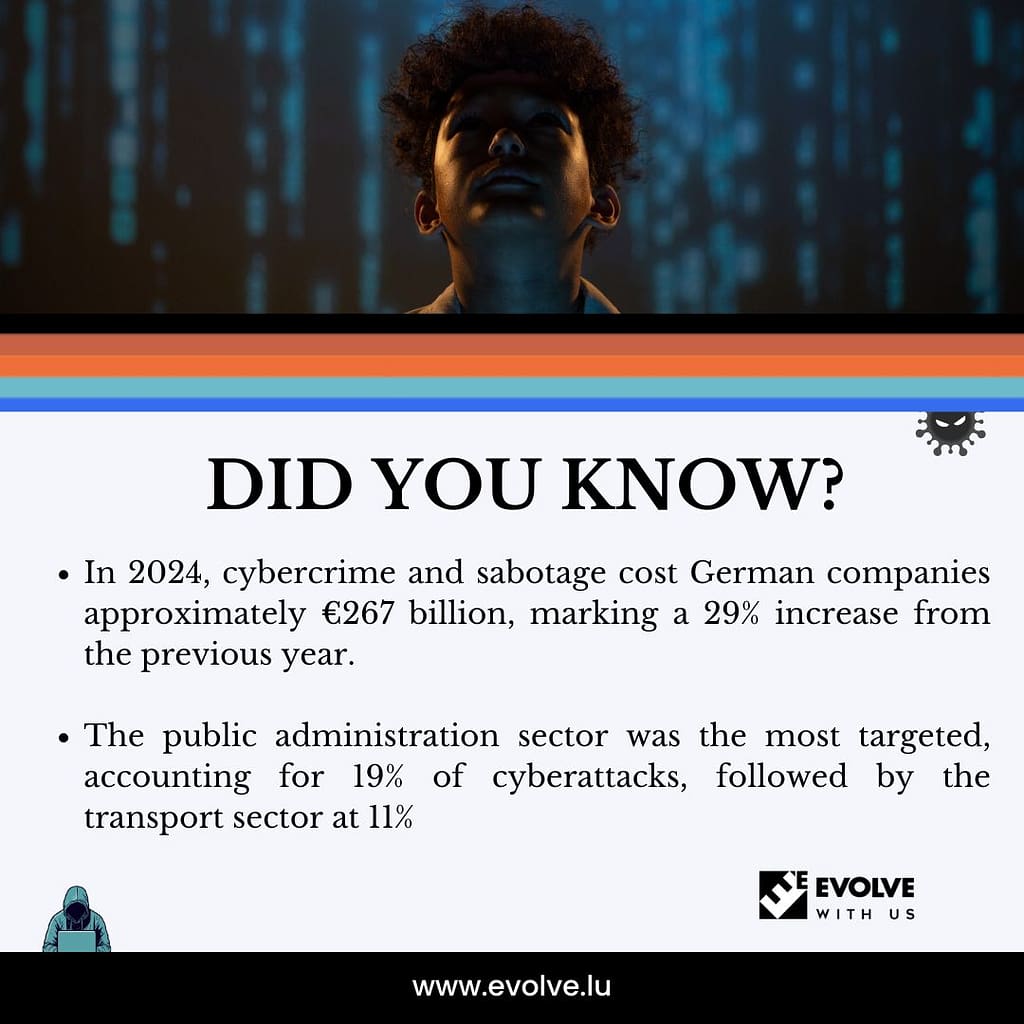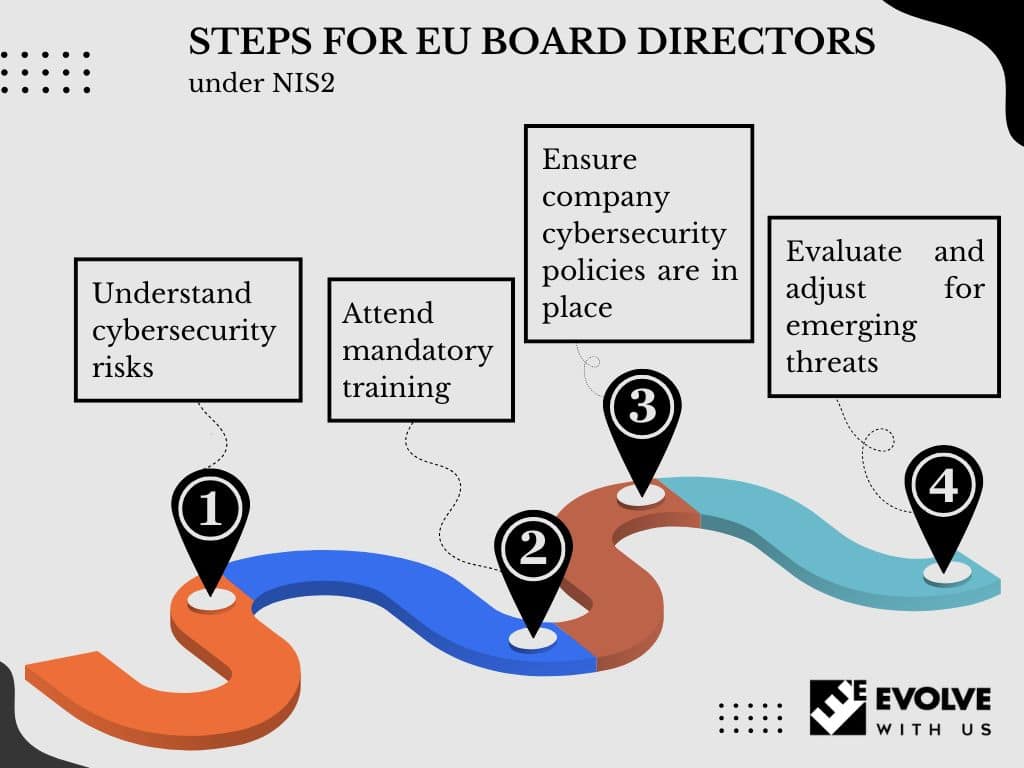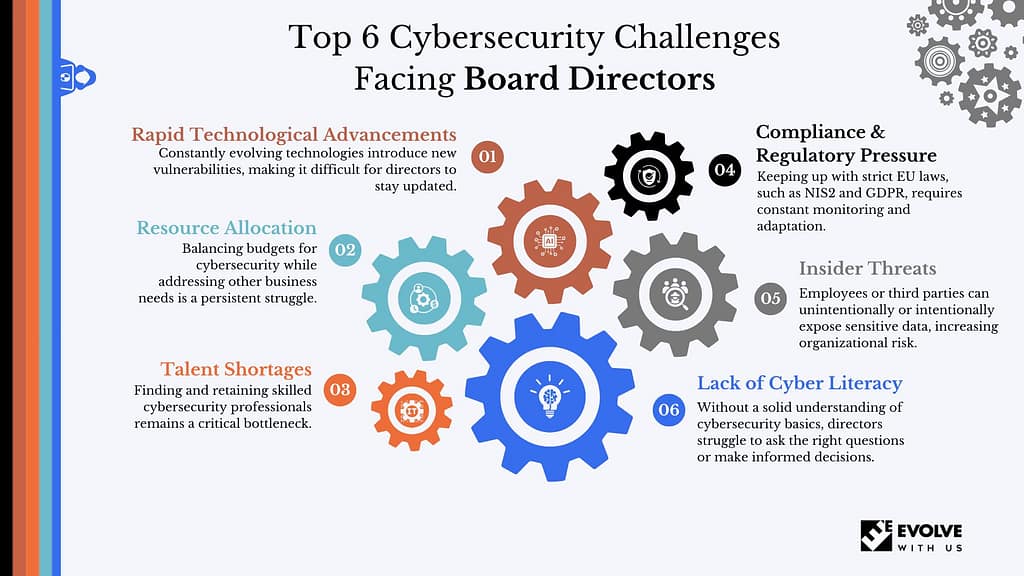Cybersecurity has become a top priority for every company. Cyber attacks are growing faster than ever, and board directors are key in keeping their organizations safe. This article explains the role of directors in cybersecurity, the challenges they face, and why understanding basic cybersecurity is essential.
In 2024, companies in Europe faced over 1,300 cyber attacks per week. These attacks don’t just target IT systems; they threaten entire businesses. Directors need to know how to respond and protect their company.
By the End of this article, you’ll have an understanding about:
- What Cybersecurity Attacks Are.
- What responsibilities do you have as a board director in the EU.
- What your role as a director in cybersecurity looks like.
- The biggest challenges you might face.
- Why learning about cybersecurity can help you lead better.
1. A Brief about Cybersecurity Attacks:
Cybersecurity attacks are unauthorized attempts to steal, expose, alter, disable, or destroy information through digital means. These attacks can target businesses of any size, often resulting in financial losses, reputational damage, and legal complications.

Cyber attacks matter because they disrupt operations, compromise customer data, and lead to significant financial consequences.
For businesses in the EU, understanding these threats is vital to comply with regulations like GDPR and the NIS2 Directive.
A. Cyber Attacks Methods:
In recent years, cyber threats have become increasingly sophisticated. Attackers are no longer using basic methods; instead, they deploy advanced tactics like ransomware, phishing, and zero-day exploits.
| Attack Type | Description | Potential Impact on Businesses |
| Ransomware | Malicious software that encrypts files, demanding payment for their release. | Data loss, operational downtime, ransom payment, and potential non-compliance with EU regulations if personal data is affected. |
| Phishing | Fraudulent emails or messages tricking employees into sharing sensitive data. | Compromised credentials, financial fraud, and exposure of confidential business information. |
| Zero-Day Exploits | Attacks exploiting vulnerabilities not yet patched by software providers. | Unauthorized access to systems, intellectual property theft, and prolonged exposure to risks. |
Cybersecurity Attacks by the Numbers:
| Metric | Details |
| Average Weekly Cyber Attacks in the EU | Over 1,300 attacks per week in 2024, marking a 28% rise compared to the previous year. |
| Ransomware Incidents | 66% of European companies experienced a ransomware attack in the last year. |
| Financial Impact | Average cost of a data breach in Europe: €4.67 million, according to IBM’s 2023 report. |
| Human Error Contribution | Over 85% of successful breaches stemmed from phishing or other employee mistakes. |
B. Cybersecurity Attacks Examples in the EU
| Company | Country | Attack Type | Impact |
| Maersk Shipping | Denmark | Ransomware (NotPetya) | Operations halted, costing the company €250 million in damages. |
| Telecom Italia | Italy | Data Breach | Regulatory fines under GDPR and significant reputational damage. |
| Travelex | UK | Ransomware | €25 million financial loss and bankruptcy filing in 2020. |
C. Why Understanding These Threats Matters for Directors
As a board director in the EU, you are responsible for guaranteeing your company is protected. Understanding these threats helps you make informed decisions, manage resources effectively, and stay compliant with regulations.
Next, we’ll explore your specific responsibilities as a board director in the EU’s cybersecurity ecosystem.
2. Regulatory Responsibilities for EU Board Directors
A. Overview of NIS2 Directive
The NIS2 Directive is a key piece of EU legislation designed to improve European cybersecurity. It holds board directors accountable for confirming that their organizations have strong cybersecurity measures in place.
This includes overseeing risk management, responding to incidents, and ensuring the organization complies with EU security requirements. The directive stresses that cybersecurity is no longer just the responsibility of the IT department but must be managed at the board level.

B. Mandatory Training Requirements
Under the NIS2 Directive, board members must have a basic understanding of cybersecurity. The directive mandates that board directors undergo regular training to stay updated on emerging cyber threats and the best practices to handle them.
This training is essential to make informed decisions, assess risks, and lead the organization through cybersecurity challenges. The goal is to make sure that directors are not only aware of potential threats but also equipped to take necessary actions to protect their businesses.
3. Key Roles & Responsibilities of Board Directors in Cybersecurity
As a board director, your role in cybersecurity goes beyond simply overseeing IT systems. You are responsible for ensuring your organization has robust cybersecurity policies, risk management strategies, and an effective response plan to deal with potential attacks. Here’s a breakdown of the key responsibilities:
A. Strategic Oversight
Board directors are crucial in setting the direction for cybersecurity within the organization. This includes:
- Approving cybersecurity policies and frameworks: Directors must ensure that the organization has a clear, actionable cybersecurity strategy in place.
- Aligning cybersecurity with business goals: Cybersecurity efforts should support the company’s overall mission, growth, and objectives.
- Monitoring compliance: Ensure that the company meets both legal and regulatory cybersecurity requirements (e.g., GDPR, NIS2).
Table: Key Actions for Strategic Oversight by Board Directors
| Action | Description |
| Approve Cybersecurity Strategy | Ensure a comprehensive, company-wide cybersecurity strategy is developed and approved. |
| Align Cybersecurity with Business Goals | Ensure cybersecurity goals are in line with the company’s mission and objectives. |
| Monitor Regulatory Compliance | Oversee that the organization meets legal standards and regulations. |
B. Risk Management
Cyber threats are constantly evolving, and directors must play a role in managing these risks effectively.
- Identify and assess risks: Work with your IT and security teams to regularly assess potential cybersecurity threats and vulnerabilities.
- Allocate resources for risk mitigation: Ensure that adequate budget, time, and personnel are allocated to mitigate cyber risks.
- Continuously evaluate risk exposure: Regularly assess the organization’s risk exposure, keeping in mind emerging threats and changes in technology.
Table: Risk Management Responsibilities by Board Directors
| Action | Description |
| Identify Potential Risks | Work with the security team to identify current and emerging cyber threats. |
| Allocate Resources for Mitigation | Ensure adequate investment in cybersecurity tools and personnel. |
| Regularly Reassess Risks | Continuously evaluate the organization’s risk exposure to cyber threats. |
C. Incident Response Preparedness
Effective incident response is critical in minimizing the damage caused by cyberattacks. Board members must:
- Ensure incident response plans are in place: Ensure that your organization has a tested and effective response plan for cyber incidents (e.g., data breaches, ransomware).
- Review and update the plan regularly: Cyber threats change quickly, so it’s vital to keep the response plan current.
- Lead decision-making during incidents: In case of a major cybersecurity incident, board directors must take charge of decision-making and coordinate with management.
Table: Incident Response Preparedness
| Action | Description |
| Ensure Response Plans Are in Place | Oversee the development and approval of incident response plans. |
| Update Plans Regularly | Review and adjust plans as new cyber threats emerge. |
| Take Charge During Cyber Incidents | Lead decision-making during a cyberattack or data breach. |

Summary: The Role of Board Directors in Cybersecurity
“As a board director, your main responsibilities in cybersecurity are to oversee the creation and approval of policies, assess and manage cyber risks, and ensure that effective response plans are in place. Your involvement is critical to protect the organization from cyber threats and to align security efforts with business goals.”
With your role clarified in the Cybersecurity landscape, let’s now explore the challenges directors face in navigating the evolving cybersecurity landscape.
4. Top Challenges Faced by Board Directors in Cybersecurity
Board directors face several challenges in managing cybersecurity effectively. Below, we outline the most critical issues and provide simple explanations, examples, and practical solutions.
A. Rapid Technological Advancements
The pace of technological change creates new cyber risks that are hard to predict and understand. For instance, advancements like AI, IoT, and 5G introduce vulnerabilities for hackers to exploit.
Example: A company integrating IoT devices may overlook securing them, allowing hackers to access sensitive systems.
Solution:
- Stay informed through regular updates on emerging cyber risks.
- Invest in technology audits to assess vulnerabilities.
| Challenge | Example | Solution |
| New technologies like IoT | IoT devices exposing critical systems | Regular security audits |
| Artificial Intelligence (AI) | AI used by hackers for advanced attacks | Continuous learning for board members |
| Remote Work | Unsecured employee networks | Establish secure remote work policies |
B.Resource Allocation
Balancing cybersecurity spending with other business priorities can be tough. Directors must decide how much to invest in security without straining budgets.
Example: A small business may skip hiring a cybersecurity team to cut costs, leading to vulnerabilities.
Solution:
- Prioritize cybersecurity as a business-critical investment.
- Partner with managed security service providers (MSSPs) to reduce costs.
| Challenge | Example | Solution |
| Limited budgets | No dedicated cybersecurity personnel | Use MSSPs for cost-effective solutions |
| High cost of software solutions | Not investing in threat-detection tools | Evaluate affordable, scalable tools |
| Competing business priorities | Focusing on growth over cybersecurity | Emphasize security as part of strategy |
C. Talent Acquisition
Finding and retaining skilled cybersecurity professionals is a global challenge, especially for EU companies. Cyber experts are in high demand and short supply.
Example: A company struggling to recruit specialists may face prolonged vulnerabilities.
Solution:
- Provide competitive salaries and professional development opportunities.
- Use external consultants or freelance experts to fill immediate gaps.
| Challenge | Example | Solution |
| Shortage of skilled experts | Long hiring process for cybersecurity roles | Hire consultants or freelancers |
| Retaining top talent | Experts leaving for better opportunities | Offer career growth and certifications |
| Lack of internal expertise | Staff unaware of latest threats | Provide cybersecurity training programs |

D. Proposed Solutions for All Challenges
- Education and Training: Regular cybersecurity training for directors and employees.
- Collaboration: Work with industry groups and government bodies to share knowledge.
- Cybersecurity Frameworks: Adopt standards like ISO 27001 to guide your company’s security strategy.
In the rapidly evolving digital world, cybersecurity is no longer a “nice-to-have” — it’s a business-critical skill every board director must master. From safeguarding sensitive company data to navigating the complexities of EU regulations, staying informed is key to effective leadership.
The Challenge Every Board Director Faces
Cyber risks are not just technical threats; they’re existential threats to your business. Directors across Europe grapple with:
- Overwhelming Complexity: Emerging threats like ransomware and phishing evolve daily.
- Regulatory Pressure: Keeping pace with frameworks like GDPR and the NIS2 Directive.
- Knowledge Gaps: Making decisions without understanding the technical landscape.
Addressing these challenges isn’t optional; it’s essential. The stakes are high, and the consequences of unpreparedness are severe — operational disruptions, financial penalties, and reputational damage.
The Imperative of Cybersecurity Education for Board Members
Cybersecurity education is essential for board directors to stay ahead of risks and lead their organizations effectively. As decision-makers, understanding the basics is no longer optional—it’s a core responsibility.
A.Why Cyber Literacy Matters
- Informed Decisions: Directors with basic cybersecurity knowledge can ask the right questions and allocate resources wisely.
- Risk Awareness: Knowing the threats enables better strategies for prevention and response.
- Regulatory Compliance: Understanding frameworks like GDPR and NIS2 avoids costly penalties.
| Cyber Literacy Benefits | Examples |
| Identify Risks | Recognize phishing emails or ransomware attempts. |
| Effective Budgeting | Invest in tools like firewalls or employee training programs. |
| Collaborate with IT Teams | Understand technical reports and respond strategically. |
B.Fostering a Security-First Culture
Educated directors create a ripple effect, promoting cybersecurity awareness throughout the organization.
| How Leadership Drives Security Culture | Example Actions |
| Set Expectations | Regularly review and discuss cybersecurity in board meetings. |
| Lead by Example | Enroll in cybersecurity training and encourage others to follow. |
| Allocate Resources | Dedicate funds for staff education and modern security systems. |
C. Key Takeaways
- Cyber literacy empowers directors to lead confidently.
- A security-first culture begins with informed leadership.
- Understanding the basics ensures compliance and stronger defenses.
By focusing on education, board members can protect their organizations, build trust, and stay ahead in a constantly changing digital landscape.
Conclusion
Cybersecurity is one of the biggest challenges for businesses today. For board directors, it goes beyond a technical issue; it’s about safeguarding the organization’s future. Your decisions play a crucial role in determining how effectively your company can prevent, handle, and recover from cyber threats.
By understanding the risks, building strong policies, and promoting a culture of security, you can turn these challenges into opportunities for growth and resilience. As a leader, your focus on cybersecurity today will shape the strength and success of your organization tomorrow.

Protect Your Organization’s Future
Cyber threats are escalating, posing significant risks to businesses worldwide. As a board director, it’s imperative to be equipped with the knowledge to effectively oversee and manage cyber risks. Our comprehensive e-learning course is tailored to provide you with the essential tools and insights needed to safeguard your organization.
Cybersecurity Course Highlights:
- Core Concepts of Cybersecurity: Gain a solid understanding of cloud, application, network, and critical infrastructure security.
- Threat Identification: Learn to recognize and respond to malware, ransomware, and phishing attacks.
- Regulatory Frameworks: Stay informed about GDPR, ISO27001 standards, and other EU regulations.
- Strategic Planning: Develop skills to implement and oversee effective cybersecurity strategies within your organization.
- Real-World Case Studies: Analyze notable incidents to understand the impact and response strategies.
Why Enroll in our Cybersecurity Course?
- Stay Ahead of Threats: Equip yourself with the latest knowledge to protect your organization.
- Ensure Compliance: Understand and adhere to essential regulatory requirements.
- Lead with Confidence: Make informed decisions to strengthen your organization’s cybersecurity posture.
Enroll Today in our Cybersecurity Course
Invest in your cybersecurity expertise to safeguard your organization’s future. Enroll in our IT & Cybersecurity course for Board Directors & Staff to lead with confidence in the evolving digital landscape.

